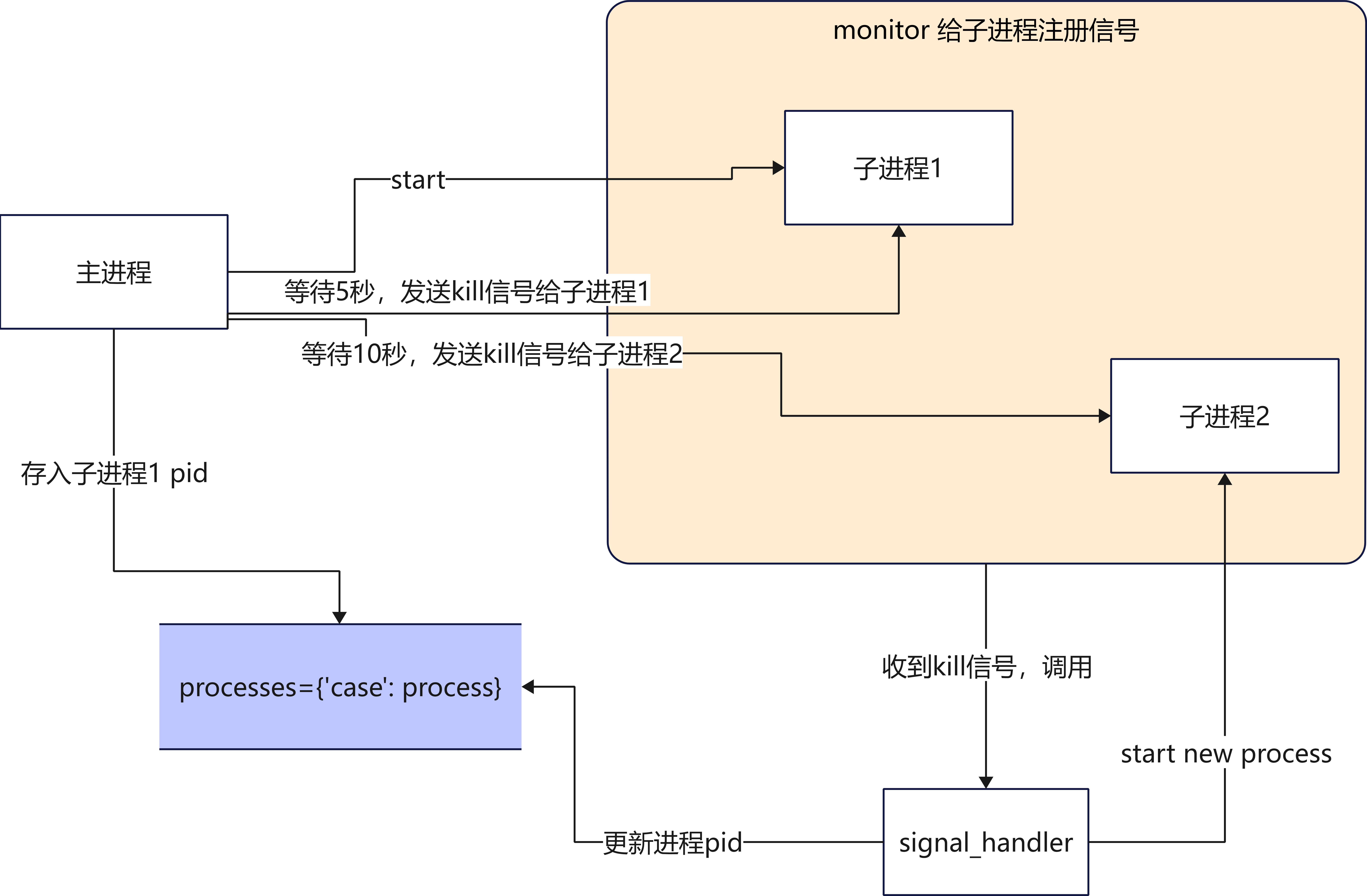如何用Python实现配置热加载?
背景
由于最近工作需求,需要在已有项目添加一个新功能,实现配置热加载的功能。所谓的配置热加载,也就是说当服务收到配置更新消息之后,我们不用重启服务就可以使用最新的配置去执行任务。
如何实现
下面我分别采用多进程、多线程、协程的方式去实现配置热加载。
使用多进程实现配置热加载
如果我们代码实现上使用多进程, 主进程1来更新配置并发送指令,任务的调用是进程2,如何实现配置热加载呢?
使用signal信号量来实现热加载

当主进程收到配置更新的消息之后(配置读取是如何收到配置更新的消息的? 这里我们暂不讨论), 主进程就向进子程1发送kill信号,子进程1收到kill的信号就退出,之后由信号处理函数来启动一个新的进程,使用最新的配置文件来继续执行任务。
main 函数
def main():
# 启动一个进程执行任务
p1 = Process(target=run, args=("p1",))
p1.start()
monitor(p1, run) # 注册信号
processes["case100"] = p1 #将进程pid保存
num = 0
while True: # 模拟获取配置更新
print(
f"{multiprocessing.active_children()=}, count={len(multiprocessing.active_children())}\n")
print(f"{processes=}\n")
sleep(2)
if num == 4:
kill_process(processes["case100"]) # kill 当前进程
if num == 8:
kill_process(processes["case100"]) # kill 当前进程
if num == 12:
kill_process(processes["case100"]) # kill 当前进程
num += 1
signal_handler 函数
def signal_handler(process: Process, func, signum, frame):
# print(f"{signum=}")
global counts
if signum == 17: # 17 is SIGCHILD
# 这个循环是为了忽略SIGTERM发出的信号,避免抢占了主进程发出的SIGCHILD
for signame in [SIGTERM, SIGCHLD, SIGQUIT]:
signal.signal(signame, SIG_DFL)
print("Launch a new process")
p = multiprocessing.Process(target=func, args=(f"p{counts}",))
p.start()
monitor(p, run)
processes["case100"] = p
counts += 1
if signum == 2:
if process.is_alive():
print(f"Kill {process} process")
process.terminate()
signal.signal(SIGCHLD, SIG_IGN)
sys.exit("kill parent process")
完整代码如下:
#! /usr/local/bin/python3.8
from multiprocessing import Process
from typing import Dict
import signal
from signal import SIGCHLD, SIGTERM, SIGINT, SIGQUIT, SIG_DFL, SIG_IGN
import multiprocessing
from multiprocessing import Process
from typing import Callable
from data import processes
import sys
from functools import partial
import time
processes: Dict[str, Process] = {}
counts = 2
def run(process: Process):
while True:
print(f"{process} running...")
time.sleep(1)
def kill_process(process: Process):
print(f"kill {process}")
process.terminate()
def monitor(process: Process, func: Callable):
for signame in [SIGTERM, SIGCHLD, SIGINT, SIGQUIT]:
# SIGTERM is kill signal.
# No SIGCHILD is not trigger singnal_handler,
# No SIGINT is not handler ctrl+c,
# No SIGQUIT is RuntimeError: reentrant call inside <_io.BufferedWriter name='<stdout>'>
signal.signal(signame, partial(signal_handler, process, func))
def signal_handler(process: Process, func, signum, frame):
print(f"{signum=}")
global counts
if signum == 17: # 17 is SIGTERM
for signame in [SIGTERM, SIGCHLD, SIGQUIT]:
signal.signal(signame, SIG_DFL)
print("Launch a new process")
p = multiprocessing.Process(target=func, args=(f"p{counts}",))
p.start()
monitor(p, run)
processes["case100"] = p
counts += 1
if signum == 2:
if process.is_alive():
print(f"Kill {process} process")
process.terminate()
signal.signal(SIGCHLD, SIG_IGN)
sys.exit("kill parent process")
def main():
p1 = Process(target=run, args=("p1",))
p1.start()
monitor(p1, run)
processes["case100"] = p1
num = 0
while True:
print(
f"{multiprocessing.active_children()=}, count={len(multiprocessing.active_children())}\n")
print(f"{processes=}\n")
time.sleep(2)
if num == 4:
kill_process(processes["case100"])
if num == 8:
kill_process(processes["case100"])
if num == 12:
kill_process(processes["case100"])
num += 1
if __name__ == '__main__':
main()
执行结果如下:
multiprocessing.active_children()=[<Process name='Process-1' pid=2533 parent=2532 started>], count=1
processes={'case100': <Process name='Process-1' pid=2533 parent=2532 started>}
p1 running...
p1 running...
kill <Process name='Process-1' pid=2533 parent=2532 started>
multiprocessing.active_children()=[<Process name='Process-1' pid=2533 parent=2532 started>], count=1
processes={'case100': <Process name='Process-1' pid=2533 parent=2532 started>}
signum=17
Launch a new process
p2 running...
p2 running...
multiprocessing.active_children()=[<Process name='Process-2' pid=2577 parent=2532 started>], count=1
processes={'case100': <Process name='Process-2' pid=2577 parent=2532 started>}
p2 running...
p2 running...
multiprocessing.active_children()=[<Process name='Process-2' pid=2577 parent=2532 started>], count=1
processes={'case100': <Process name='Process-2' pid=2577 parent=2532 started>}
p2 running...
p2 running...
multiprocessing.active_children()=[<Process name='Process-2' pid=2577 parent=2532 started>], count=1
processes={'case100': <Process name='Process-2' pid=2577 parent=2532 started>}
p2 running...
p2 running...
kill <Process name='Process-2' pid=2577 parent=2532 started>
signum=17
Launch a new process
multiprocessing.active_children()=[<Process name='Process-2' pid=2577 parent=2532 stopped exitcode=-SIGTERM>], count=1
processes={'case100': <Process name='Process-3' pid=2675 parent=2532 started>}
p3 running...
p3 running...
multiprocessing.active_children()=[<Process name='Process-3' pid=2675 parent=2532 started>], count=1
总结:
好处:使用信号量可以处理多进程之间通信的问题。
坏处:代码不好写,写出来代码不好理解。信号量使用必须要很熟悉,不然很容易自己给自己写了一个bug.(所有初学者慎用,老司机除外。)
还有一点不是特别理解的就是process.terminate() 发送出信号是SIGTERM number是15,但是第一次signal_handler收到信号却是number=17,如果我要去处理15的信号,就会导致前一个进程不能kill掉的问题。欢迎有对信号量比较熟悉的大佬,前来指点迷津,不甚感谢。
采用multiprocessing.Event 来实现配置热加载
实现逻辑是主进程1 更新配置并发送指令。进程2启动调度任务。
这时候当主进程1更新好配置之后,发送指令给进程2,这时候的指令就是用Event一个异步事件通知。
直接上代码
scheduler 函数
def scheduler():
while True:
print('wait message...')
case_configurations = scheduler_notify_queue.get()
print(f"Got case configurations {case_configurations=}...")
task_schedule_event.set() # 设置set之后, is_set 为True
print(f"Schedule will start ...")
while task_schedule_event.is_set(): # is_set 为True的话,那么任务就会一直执行
run(case_configurations)
print("Clearing all scheduling job ...")
event_scheduler 函数
def event_scheduler(case_config):
scheduler_notify_queue.put(case_config)
print(f"Put cases config to the Queue ...")
task_schedule_event.clear() # clear之后,is_set 为False
print(f"Clear scheduler jobs ...")
print(f"Schedule job ...")
完成代码如下:
import multiprocessing
import time
scheduler_notify_queue = multiprocessing.Queue()
task_schedule_event = multiprocessing.Event()
def run(case_configurations: str):
print(f'{case_configurations} running...')
time.sleep(3)
def scheduler():
while True:
print('wait message...')
case_configurations = scheduler_notify_queue.get()
print(f"Got case configurations {case_configurations=}...")
task_schedule_event.set()
print(f"Schedule will start ...")
while task_schedule_event.is_set():
run(case_configurations)
print("Clearing all scheduling job ...")
def event_scheduler(case_config: str):
scheduler_notify_queue.put(case_config)
print(f"Put cases config to the Queue ...")
task_schedule_event.clear()
print(f"Clear scheduler jobs ...")
print(f"Schedule job ...")
def main():
scheduler_notify_queue.put('1')
p = multiprocessing.Process(target=scheduler)
p.start()
count = 1
print(f'{count=}')
while True:
if count == 5:
event_scheduler('100')
if count == 10:
event_scheduler('200')
count += 1
time.sleep(1)
if __name__ == '__main__':
main()
执行结果如下:
wait message...
Got case configurations case_configurations='1'...
Schedule will start ...
1 running...
1 running...
Put cases config to the Queue ...
Clear scheduler jobs ...
Schedule job ...
Clearing all scheduling job ...
wait message...
Got case configurations case_configurations='100'...
Schedule will start ...
100 running...
Put cases config to the Queue ...
Clear scheduler jobs ...
Schedule job ...
Clearing all scheduling job ...
wait message...
Got case configurations case_configurations='200'...
Schedule will start ...
200 running...
200 running...
总结:
使用Event事件通知,代码不易出错,代码编写少,易读。相比之前信号量的方法,推荐大家多使用这种方式。
使用多线程或携程的方式,其实和上述实现方式一致。唯一区别就是调用了不同库中,queue 和 event.
# threading
scheduler_notify_queue = queue.Queue()
task_schedule_event = threading.Event()
# async
scheduler_notify_queue = asyncio.Queue()
task_schedule_event = asyncio.Event()
结语:
具体的实现的方式有很多,也各自有各自的优劣势。我们需要去深刻理解到需求本身,才去做技术选型。
如何用Python实现配置热加载?的更多相关文章
- Aspnetcore下面服务器热更新与配置热加载
原文:Aspnetcore下面服务器热更新与配置热加载 Asp.net的热更新方案Appdomain在aspnetcore中不被支持了 新的方案如下: 配置文件更新选项 reloadOnChange ...
- 在线配置热加载配置 go-kratos.dev 监听key
paladin https://v1.go-kratos.dev/#/config-paladin example Service(在线配置热加载配置) # service.go type Servi ...
- nginx多进程模型之配置热加载---转
http://blog.csdn.net/brainkick/article/details/7176405 前言: 服务器程序通常都会通过相应的配置文件来控制服务器的工作.很多情况下,配置文件会经常 ...
- (译文)开始学习Webpack-应用TypeScript,配置热加载和Source Map
项目初始化:采用TypeScript 我们的版本是: $ node --version v8.5.0 $ npm --version 5.5.1 npm版本升级了,因为npm最近带来了新特性,本地会生 ...
- springboot idea 配置热加载
在idea 配置springboot的热加载,只需要三步: 第一步.引用jar包 <dependency> <groupId>org.springframework.boot& ...
- 关于在Intellij IDEA工具中配置热加载问题
第一步,创建一个maven项目,然后在pom.xml文件中添加依赖(上图内容). 第二步:来到intellij idea主页面,点击File->Settings->Build->co ...
- idea配置热加载
第一步:添加依赖 spring-boot项目中引入如下依赖 <dependency> <groupId>org.springframework.boot</groupId ...
- SpringBoot入门笔记(三)、热加载
1.配置热加载环境,在pom.xml添加如下代码 <build> <!--springloader plugin --> <plugins> <plugin& ...
- spring-boot-devtools热加载不起作用
在开发过程中,希望修改时能够及时更新修改,即热加载,但是spring-boot-devtools不起作用.这主要是两个原因导致. 一.spring-boot-maven-plugin插件没有配置,如下 ...
随机推荐
- pyqt5 重启相同线程错误:QThread: Destroyed while thread is still running
背景: 把一个基于QObject的类的槽运行在另一个线程,我们可以用moveToThread的方法. 1 新建一个子线程类,编写槽函数和信号,MyClass *m_MyClass=new MyClas ...
- mysql内连接查询之自连接
连接查询: 当查询数据时,通过连接操作查询出存放在多个表中的不同数据,当两个或者多个表中存在相同意义的字段时, 便可以通过这些字段对不同的表进行连接查询. 自连接: 如果在一个连接查询中,涉及的两个表 ...
- AliIAC 智能音频编解码器:在有限带宽条件下带来更高质量的音频通话体验
随着信息技术的发展,人们对实时通信的需求不断增加,并逐渐成为工作生活中不可或缺的一部分.每年海量的音视频通话分钟数对互联网基础设施提出了巨大的挑战.尽管目前全球的互联网用户绝大多数均处于良好的网络状况 ...
- 进程线程协程补充、docker-compose一键部署项目、搭建代理池、requests超时设置、认证设置、异常处理、上传文件
今日内容概要 补充:进程,线程,协程 docker-compose一键部署演示 搭建代理池 requests超时设置 requests认证设置 requests异常处理 requests上传文件 内容 ...
- 斯坦福NLP课程 | 第11讲 - NLP中的卷积神经网络
作者:韩信子@ShowMeAI,路遥@ShowMeAI,奇异果@ShowMeAI 教程地址:http://www.showmeai.tech/tutorials/36 本文地址:http://www. ...
- kernel heap bypass smep,smap && 劫持modprobe_path
kernel heap bypass smep,smap && 劫持modprobe_path exp1 smep:smep即用户数据不可执行,当 CPU 处于 ring0 模式时,执 ...
- SQL多表多字段比对方法
目录 表-表比较 整体思路 找出不同字段的明细 T1/T2两表ID相同的部分,是否存在不同NAME 两表的交集与差集:判断两表某些字段是否相同 两表的交集与差集:找出T2表独有的id 字段-字段比较 ...
- 难对齐、难保障、难管理?一文了解字节跳动如何解决数据SLA治理难题
基于字节跳动分布式治理的理念,数据平台数据治理团队自研了SLA保障平台,目前已在字节内部得到广泛使用,并支持了绝大部分数据团队的SLA治理需求,每天保障的SLA链路数量过千,解决了数据SLA难对齐.难 ...
- 20212115 实验三 《python程序设计》实验报告
实验报告 20212115<python程序设计>实验三报告 课程:<Python程序设计>班级: 2121姓名: 朱时鸿学号:20212115实验教师:王志强老师实验日期:2 ...
- Django-request的常见属性
瞧一瞧,看一看,Django时,获取Request的各个属性. Request的常见属性 request.META 返回一个python字典.它包含了所有的HTTP请求信息.如下代码: 点击查看代码 ...
